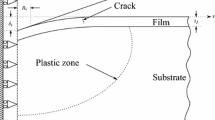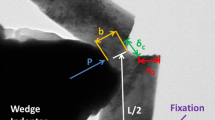Abstract
An experimental technique is presented for measuring the fracture toughness of brittle thin films. In this technique, long rectangular membranes are fabricated from the film of interest using standard silicon micromachining techniques. A focused ion beam is then used to introduce pre-cracks of different lengths along the centerline of the membranes and the membranes are pressurized until rupture. The fracture stress of the membrane is measured as a function of pre-crack length and the fracture toughness of the film is determined from a simple fracture mechanics analysis. The technique is applicable to a wide range of materials and is especially suited for ultra-thin films. We have demonstrated the experimental procedure for a 150 nm AlTa intermetallic film and obtained a room-temperature fracture toughness of K 1c = 4.44 ± 0.21 MPam1/2.
Similar content being viewed by others
References
Bagdahn J, Sharpe WN and Jadaan O (2003). Fracture strength of polysilicon at stress concentrations. J Microelectromech Syst 12: 302
Ballarini R, Mullen RL, Yin Y, Kahn H, Stemmer S and Heuer AH (1997). The fracture toughness of polysilicon microdevices: a first report. J Mater Res 12: 915
Beams JW (1959) Mechanical properties of thin films of gold and silver. In: Neugebauer CA, Newkirk JB, and Vermilyea DA (eds) Structure and properties of thin films. John Wiley and Sons, Inc., p 183
Beuth JL (1991). Cracking of thin bonded films in residual tension. Int J Solids Struct 29: 1657
Broek D (1989). Elementary engineering fracture mechanics. Kluwer Academic Publishers, Dordrecht
Chasiotis I and Knauss WG (2003). The mechanical strength of polysilicon films: part 2. Size effects associated with elliptical and circular perforations. J Mech Phys Solids 51: 1551
Espinosa HD and Peng B (2005). A new methodology to investigate fracture toughness of freestanding MEMS and advanced materials in thin film form. J Microelectromech Syst 14: 153
He J, Xu G, Suo Z (2004) Experimental determination of crack driving forces in integrated structures. In: Ho PS, Baker SP, Nakamura T, Volkert CA (eds) In: Proceedings of the 7th international workshop on stress-induced phenomena in metallization, Austin, Texas, June 2004, pp 3–14, American Institute of Physics, New York
Ina K and Koizumi H (2004). Penetration of liquid metals into solid metals and liquid metal embrittlement. Mater Sci Eng A 387: 390–394
Inglis CE (1913). Stresses in a plate due to the presence of cracks and sharp corners. Transac Inst Naval Architects 55: 219
Kahn H, Ballarini R, Mullen RL and Heuer AH (1999). Electrostatically actuated failure of microfabricated polysilicon fracture mechanics specimens. Proc Roy Soc Lond A 455: 3807
Kahn H, Tayebi N, Ballarini R, Mullen RL and Heuer AH (2000). Fracture toughness of polysilicon MEMS devices. Sensors Actuators A 82: 274
Mahne S, Krumeich F and Harbrecht B (1993). Phase-relations in the Al–Ta System—on the translational symmetries of Al3Ta2 and AlTa. J Alloy Compd 201: 167
Pugno N, Peng B and Espinosa HD (2005). Predictions of strength in MEMS components with defects—a novel experimental-theoretical approach. Int J Solids Struct 42: 647
Sigle W, Richter G, Ruhle M and Schmidt S (2006). Insight into the atomic-scale mechanism of liquid metal embrittlement. J Appl Phys 89: 121911
Su PJ and Chung CK (2005). Amorphization of Ta–Al films using magnetron sputtering. Surf Coat Technol 200: 1664
Subramanian PR, Miracle DB and Mazdiyasni S (1990). Phase-relationships in the Al–Ta System. Metallurgic Transac 21A: 539
Tabata O, Kawahata K, Sugiyama S and Igarashi I (1989). Mechanical property measurement of thin films using load-deflection of composite rectangular membranes. Sensors Actuators 20: 135
Vlassak JJ and Nix WD (1992). A new bulge test technique for the determination of Young’s modulus and Poisson’s ratio of thin films. J Mater Res 7: 3242
Wellner P, Kraft O, Dehm G, Andersons J and Arzt E (2004). Channel cracking of β-NiAl thin films on Si substrates. Acta Materialia 52: 2325
Xiang Y, Chen X and Vlassak JJ (2005). The plane-strain bulge test for thin films. J Mater Res 20: 2360
Ziegler JF, Biersack JP and Littmark U (1985). The stopping and range of ions in matter. Pergamon Press, New York
Author information
Authors and Affiliations
Corresponding author
Rights and permissions
About this article
Cite this article
Xiang, Y., McKinnell, J., Ang, WM. et al. Measuring the fracture toughness of ultra-thin films with application to AlTa coatings. Int J Fract 144, 173–179 (2007). https://doi.org/10.1007/s10704-007-9095-0
Received:
Accepted:
Published:
Issue Date:
DOI: https://doi.org/10.1007/s10704-007-9095-0




